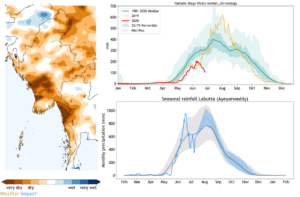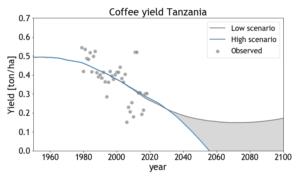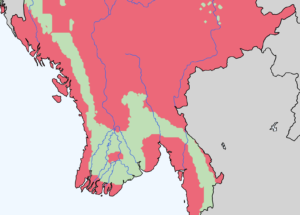Agriculture
Seamless Weather Forecasting for Farmers
For many years, agricultural practices have been based on knowledge that has been passed down from one generation to the next. However, due to climate change, this knowledge cannot be applied anymore. For example, the start and intensity of the monsoon have become increasingly unpredictable, and extreme weather situations cause more frequent floods and droughts. This has an immense impact on farming practices.
Smallholder farmers are especially vulnerable to these weather patterns since they normally rely on rainfall for irrigation; have limited options for crop protection, low access to fertilizer and chemicals, and limited insurance. Larger plantations and companies are affected by climate change too and they need accurate weather forecasts for yields profitable enough to run their business.
At Weather Impact, we perform climate analyses across, and at, various time scales. This unique approach, to combining various data sources and models into one seamless product that is tailored to your location is called Seamless Forecasting.
Understanding Seamless forecasting
The risks related to the climate differ according to the time scales:
1.) Present day: Is the current climate normal? What do the temperature and weather precipitation extremes look like over the last decade?
2.) Seasonal weather forecasting: Will the coming season be drier than normal? What will the expected yield be this season? To act, one can plant drought-resistant crops, plant their crops later than normal or adjust their agricultural practices. When the price is expected to drop in the coming months it can be strategic to store or sell their products at other times.
3.) Multi-year: How will the local climate change in the future? Will your area still be suitable to grow certain crops in 20 years? This is especially relevant for the planning of future production areas and the sustainability of existing plantations.
Figure 1: Seamless forecasting couples various data sets into one congruent data set, tailored to a specific location or region.
Below are some exampes of Seamless Forecasting being used internationally
-Example 1: Status and seasonal weather services
It is important to knowing the status of the season in combination with a seasonal weather outlook, to plan farming activities and project the expected yield for the coming season. In Myanmar, we issue a monthly seasonal weather outlook.
An example, a subset of the seasonal status for July 2020, can be seen in Figure 2. In this particular case, the monsoon season of 2020 has started in almost the whole country. Yet the received rainfall is (much) lower than normal.
Figure 2: Rainfall conditions over Myanmar compared to historic average for July 2020.
-Example 2: Coffee yield in a changing climate
Coffee grows in semi-tropical regions, and 70% of all coffee grown worldwide is Arabica coffee. This makes coffee products extremely vulnerable to climate change. The most optimal growing conditions for Arabica coffee beans are temperatures between 18 – 21 degrees Celsius. But it can tolerate annual mean temperatures of around 24 degrees Celsius. However, higher temperatures cause the beans to ripen fast and reduce their quality. By combining historical yield data and seamless forecasting data one can find a relation between climatic conditions and coffee yield. These can be combined with climate projections to project the coffee yield in the future.
An example of such a product for Tanzania is shown in Figure 3. The shaded area is the range in projected coffee yield outcomes for the coming decades. This figure shows that the coffee sector in Tanzania has an urgent problem, as the projected yield is falling fast. Tanzanian farmers can adjust to global warming by switching to other coffee varieties before it is too late to change, and coffee companies find areas that are more suitable for growing coffee in 20 to 30 years.
Figure 3: Coffee yield prediction for Tanzania based on historical climate data and the range of future climate predicted by climate models. Please note this is a country average, regionally large differences are present.
-Example 3: Climate suitability for rubber trees in Myanmar
Crops grow best under certain weather conditions (weather precipitation, humidity, temperature). For example, they can be sensitive to droughts or excessive rainfall. With this information, the suitability of regions for a specific crop can be determined. Seamless forecasting is very relevant for large existent plantations, as current locations can fast become unsuitable. On the other hand, if one must choose a new location for a plantation, it should be climate resistant. At Weather Impact we use (regional/global) climate models to locate suitable regions to grow specific crops. An example of such a product is shown in Figure 4.
Figure 4: Climate suitability for growing rubber trees in Myanmar. Suitable regions are indicated by a green colour, unsuitable regions by a red colour. We can also show future climate suitability and investigate which areas become more or less suitable than in today’s climate.





